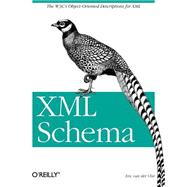
Eric van der Vlist is the resident expert on XML schema languages on XML.com. He is also a member of the ISO DSDL committee, where standardization work on RELAX NG and related specifications is in progress. Eric is also the author of O'Reilly's XML Schema.
| Preface | ix | ||||
|
1 | (5) | |||
|
1 | (3) | |||
|
4 | (2) | |||
|
6 | (9) | |||
|
6 | (1) | |||
|
7 | (6) | |||
|
13 | (2) | |||
|
15 | (6) | |||
|
15 | (2) | |||
|
17 | (4) | |||
|
21 | (23) | |||
|
21 | (2) | |||
|
23 | (1) | |||
|
24 | (6) | |||
|
30 | (4) | |||
|
34 | (7) | |||
|
41 | (1) | |||
|
41 | (1) | |||
|
41 | (3) | |||
|
44 | (25) | |||
|
45 | (14) | |||
|
59 | (2) | |||
|
61 | (2) | |||
|
63 | (2) | |||
|
65 | (4) | |||
|
69 | (17) | |||
|
69 | (1) | |||
|
70 | (1) | |||
|
71 | (1) | |||
|
72 | (7) | |||
|
79 | (4) | |||
|
83 | (3) | |||
|
86 | (41) | |||
|
86 | (1) | |||
|
87 | (1) | |||
|
88 | (3) | |||
|
91 | (24) | |||
|
115 | (4) | |||
|
119 | (2) | |||
|
121 | (5) | |||
|
126 | (1) | |||
|
127 | (14) | |||
|
127 | (2) | |||
|
129 | (6) | |||
|
135 | (2) | |||
|
137 | (4) | |||
|
141 | (12) | |||
|
141 | (1) | |||
|
142 | (7) | |||
|
149 | (2) | |||
|
151 | (2) | |||
|
153 | (31) | |||
|
153 | (3) | |||
|
156 | (2) | |||
|
158 | (6) | |||
|
164 | (1) | |||
|
165 | (1) | |||
|
166 | (3) | |||
|
169 | (6) | |||
|
175 | (2) | |||
|
177 | (2) | |||
|
179 | (2) | |||
|
181 | (3) | |||
|
184 | (13) | |||
|
184 | (5) | |||
|
189 | (5) | |||
|
194 | (1) | |||
|
195 | (2) | |||
|
197 | (16) | |||
|
197 | (8) | |||
|
205 | (8) | |||
|
213 | (11) | |||
|
213 | (9) | |||
|
222 | (2) | |||
|
224 | (11) | |||
|
224 | (2) | |||
|
226 | (5) | |||
|
231 | (1) | |||
|
232 | (1) | |||
|
233 | (2) | |||
|
235 | (70) | |||
|
305 | (32) | |||
| A. XML Schema Lanquages | 337 | (18) | |||
| B. Work in Progress | 355 | (6) | |||
| Glossary | 361 | (8) | |||
| Index | 369 |
The New copy of this book will include any supplemental materials advertised. Please check the title of the book to determine if it should include any access cards, study guides, lab manuals, CDs, etc.
The Used, Rental and eBook copies of this book are not guaranteed to include any supplemental materials. Typically, only the book itself is included. This is true even if the title states it includes any access cards, study guides, lab manuals, CDs, etc.